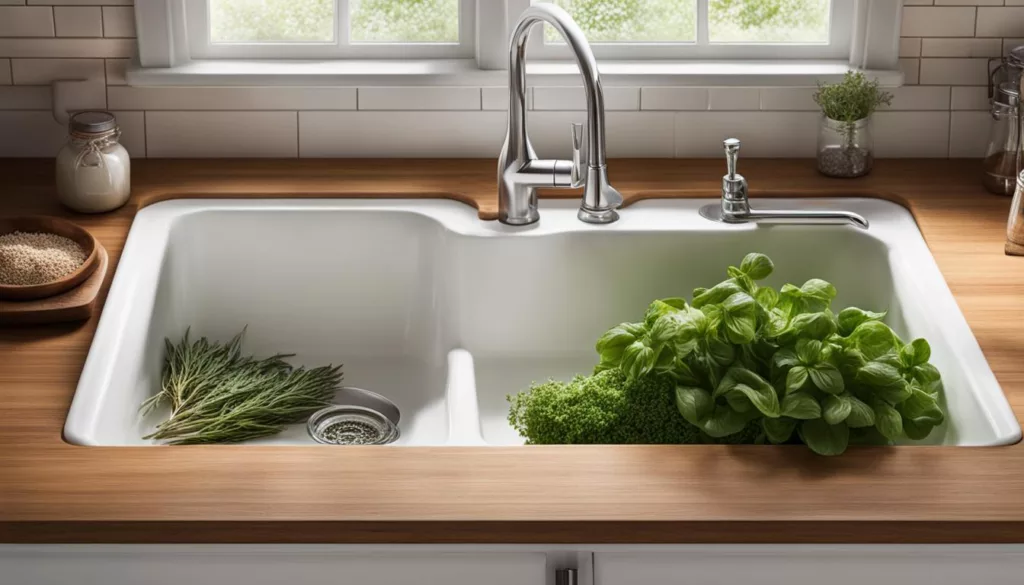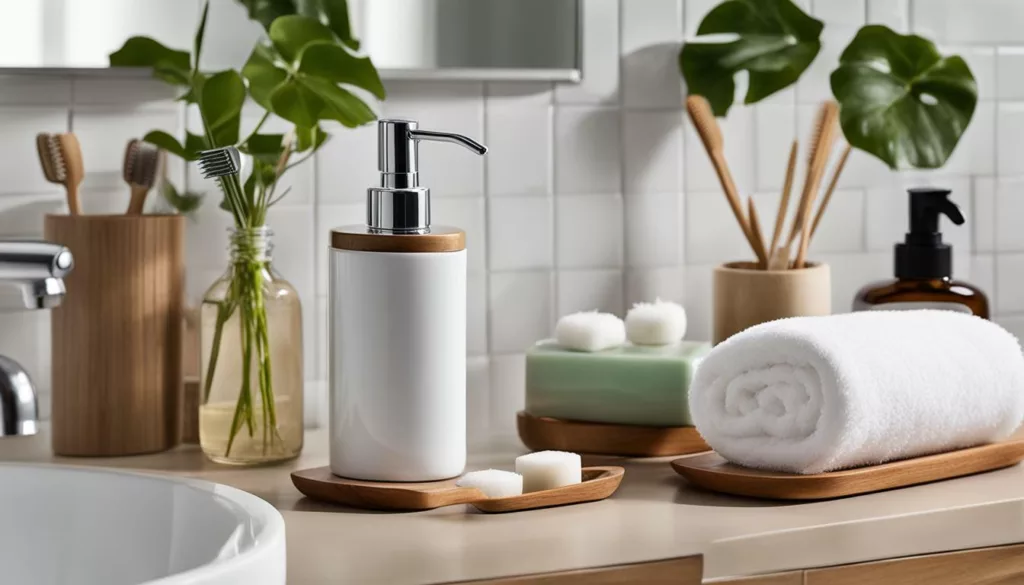Farmhouse Sinks Guide
If you’re looking to upgrade your kitchen, a farmhouse sink is an excellent choice. Not only does it add a touch of charm and elegance to your space, but it also offers practical benefits for daily use. With the right information, you can choose the perfect farmhouse sink that suits your style and needs.
In this comprehensive guide, we’ll cover everything you need to know about farmhouse sinks. From trendy styles and materials to installation tips and essential care, we’ve got you covered. Let’s dive in and explore the world of farmhouse sinks!

Key Takeaways:
- A farmhouse sink adds charm and practical benefits to your kitchen upgrade.
- You can choose from various trendy styles and materials to fit your design preferences.
- Proper installation and maintenance are essential for prolonging the life of your farmhouse sink.
- There are also downsides to consider, such as limited counter space and potential maintenance issues.
- Ultimately, the right farmhouse sink can enhance the functionality and aesthetic appeal of your kitchen.
What is a Farmhouse Sink?

If you’re looking for a sink that effortlessly blends functionality and style, a farmhouse sink might just be what you need for your kitchen. This type of sink, also known as an apron sink, boasts a classic and rustic charm that has made it a beloved choice among homeowners for decades.
The defining feature of a farmhouse sink is its exposed front, which extends beyond the cabinets and countertops. This unique design is not only aesthetically pleasing, but it also provides more workspace and depth for large pots, pans, and dishes.
You can choose from a variety of farmhouse sink designs, including single-bowl, double-bowl, and even triple-bowl options, depending on your specific needs. Farmhouse sinks also come in various materials such as fireclay, porcelain, stainless steel, and copper. Each material brings unique characteristics that cater to different preferences.
Installation of a farmhouse sink can be tricky, and you might want to seek professional help, especially if you have to make considerable modifications to your cabinets. Standard cabinets may not fit, which means you may have to make adjustments to your cabinet base so that the sink fits perfectly. Proper installation is vital for optimal functionality and longevity.
To sum it up, farmhouse sinks are a beautiful and functional addition to your kitchen. Their unique design provides ample workspace and could make a statement in your kitchen decor. Choose a style, material, and installation method that complements your kitchen design and suits your specific needs.
“The defining feature of a farmhouse sink is its exposed front, which extends beyond the cabinets and countertops.”
Advantages of Farmhouse Sink

If you’re considering a kitchen upgrade, a farmhouse sink is an excellent choice. Not only does it add a cozy and rustic touch to your home, but it also has numerous functional benefits. Here are some advantages of choosing a farmhouse sink:
| Advantages |
|---|
| Large and Deep Basin: The deep and spacious basin of the farmhouse sink provides ample space for soaking and washing big pots, pans, and even your pets. |
| Aesthetically Appealing: Farmhouse sinks’ sleek finish and apron front design elevate the look of any kitchen. They come in diverse colors, materials, and styles, enabling you to choose one that complements your kitchen’s decor. |
| Durable: Farmhouse sinks are highly durable, and constructed with heavy-duty materials such as fireclay, porcelain, and stainless steel. They can withstand substantial impact and resistance, ensuring longevity and value for your investment. |
| Easier to Reach: Installing a deeper sink implies installing it closer to your body, which makes it more comfortable and easier to clean dishes. |
| Flexible installation: The farmhouse sink can be installed under-mount or flush mount, which allows flexibility for your project. |
There are many advantages to choosing a farmhouse sink. From practicality to aesthetics, this sink type won’t disappoint you. The following sections of the guide continue to explore the farmhouse sink in-depth, including materials, styles, and installation.
Disadvantages of Farmhouse Sink

While farmhouse sinks offer numerous benefits, there are also several downsides to consider:
- Costs: Typically, farmhouse sinks are more expensive than traditional sinks due to their larger, more intricate designs and higher-end materials.
- Installation: Installing a farmhouse sink can require professional assistance, as it involves cutting the countertop and cabinetry to fit the sink’s unique dimensions. This process can be time-consuming and costly.
- Maintenance: Because of their size and design, farmhouse sinks can be more difficult to clean than traditional sinks. The exposed front can accumulate water stains and grime, requiring more upkeep to maintain its attractive appearance.
- Compatibility: Not all kitchen layouts and designs can accommodate farmhouse sinks due to their larger size and unique installation requirements.
If you’re considering a farmhouse sink, make sure to carefully weigh the advantages and disadvantages to ensure it’s the best fit for your kitchen and lifestyle.
Farmhouse Sink Styles

When it comes to farmhouse sink styles, there are various options to choose from that can complement any kitchen design. Whether you prefer a traditional look or a more modern feel, there is a farmhouse sink style for every taste. Let’s explore some of the most popular styles:
| Style | Description |
|---|---|
| Classic | The classic style features a white porcelain finish, a large deep basin, and an iconic apron front. This style is ideal for a vintage or country-inspired kitchen. |
| Contemporary | The contemporary style usually has a sleek, minimalistic design, straight lines, and angular edges. This style looks sophisticated and stunning in a modern-style kitchen. |
| Transitional | The transitional style combines classic and modern elements, creating a timeless and elegant look. This style is perfect for those who want to strike a balance between traditional and contemporary styles. |
No matter which style you choose, a farmhouse sink will always create a focal point in your kitchen, adding both functionality and personality. So, take the time to find the perfect style that complements your kitchen decor and enhances your cooking experience.
Farmhouse Sink Materials

When selecting a farmhouse sink, one of the essential factors to consider is the material. Understanding the characteristics and benefits of each material can help you choose the right one for your kitchen.
The most common farmhouse sink materials include:
| Material | Characteristics | Benefits |
|---|---|---|
| Fireclay | Durable, non-porous, resistant to stains and scratches | Easy to clean, maintains its color, retains heat well |
| Cast Iron | Heavy, sturdy, resistant to high temperatures and impact | Available in various colors, easy to clean, long-lasting |
| Stainless Steel | Lightweight, durable, resistant to corrosion and stains | Easy to clean, versatile, complements modern kitchen design |
| Copper | Antimicrobial, heat-resistant, naturally develops a patina over time | Unique, adds warmth and character to your kitchen, eco-friendly |
Ultimately, the material you choose will depend on your personal preference, lifestyle, and budget.
Farmhouse Sink Installation

Installing a farmhouse sink can seem like a daunting task, but with the right tools and knowledge, it can be a smooth process. Follow these step-by-step instructions for a successful installation:
- Preparation: Start by removing the old sink and ensuring the new farmhouse sink fits in the countertop opening. If the sink does not fit, adjust the opening before proceeding.
- Support: Apply a bead of silicone caulk around the underside edge of the sink. Place the sink into the opening, making sure to have a helper on hand to hold the sink in place while the adhesive dries.
- Bracket Installation: Install brackets to secure the sink in place, ensuring an even fit and a level sink. Consult the manufacturer’s instructions to determine the appropriate bracket placement.
- Plumbing: Connect the drain assembly and the faucet to the sink following the manufacturer’s instructions. Make sure to use the plumber’s putty or silicone caulk to seal the drain and faucet holes.
Tip: Consider hiring a professional plumber to handle the plumbing if you’re not confident in your skills, especially if adjusting the plumbing layout is necessary. - Seal: Once the sink is in place and the plumbing is connected, apply a final bead of silicone caulk to seal the sink to the countertop and prevent water from seeping underneath.
- Clean-Up: Wipe away any excess adhesive or caulk and clean the sink before use.
Common Similarities between Farmhouse and Apron Sink
It’s worth noting that apron sinks share some similarities with farmhouse sinks. Both of them feature an exposed front-facing bowl, which makes them ideal for larger kitchen tasks and offers a striking aesthetic appeal. Additionally, both sinks are available in various materials, finishes, and styles, allowing you to find a perfect fit for your kitchen’s overall design theme.
In summary, apron sinks can be a practical and appealing option for your kitchen sink upgrade, but it’s essential to weigh its advantages and disadvantages before committing to it. Remember that there are similarities between aprons and farmhouse sinks, which may help you make an informed decision that fits your kitchen’s style and functionality needs.
Conclusion
Congratulations on completing our comprehensive guide to farmhouse sinks and apron sinks. We hope this article has provided you with valuable insights into the charm and appeal of farmhouse sinks, as well as the advantages and disadvantages of incorporating an apron sink into your kitchen.
Remember to consider your specific needs and preferences when selecting the perfect farmhouse sink for your kitchen upgrade. Whether you opt for a traditional, contemporary, or transitional design, a farmhouse sink can enhance the functionality and aesthetic appeal of your space.
Thank you for reading, and happy sink shopping!
FAQ
What is an Apron Sink?
An apron sink, also known as a farmhouse sink, is a spacious and deep sink that features a protruding front panel, known as the apron. This design allows the sink to extend forward, providing a more ergonomic and comfortable washing experience. Apron sinks are typically made of durable materials such as fireclay, stainless steel, or copper and are installed by being mounted below or on top of the countertop.
What are the advantages and disadvantages of an Apron Sink?
The advantages of an apron sink include its large capacity, which allows for easier washing of large pots and pans, as well as its stylish and timeless design that adds a cozy and rustic touch to any kitchen. However, some potential disadvantages include the higher cost of apron sinks compared to traditional sinks, the need for a custom cabinet to accommodate the larger size, and the fact that the edge of the sink may be exposed and prone to chipping.
What is a Farmhouse Sink?
A farmhouse sink, also referred to as an apron sink, is a type of kitchen sink that features a deep and spacious basin with a large front apron that extends beyond the front of the countertop. This design allows for easier access and a more comfortable washing experience. Farmhouse sinks are available in various materials such as fireclay, stainless steel, cast iron, and copper, offering different aesthetic and functional options for your kitchen.
What are the advantages of a Farmhouse Sink?
Farmhouse sinks offer several advantages. They provide ample space for washing large pots, pans, and other kitchen utensils, making them ideal for avid cooks. Their unique design adds a charming, rustic appeal to any kitchen, and they can enhance the overall aesthetic value of the space. Additionally, the deeper basin of a farmhouse sink offers more comfort and flexibility during use.
What are the disadvantages of a Farmhouse Sink?
There are a few potential drawbacks to consider with a farmhouse sink. The larger size may require the modification of existing cabinetry or the installation of a new custom cabinet to accommodate it. Farmhouse sinks can also be more expensive than traditional sinks due to their unique design and material choices. Additionally, the exposed front apron of a farmhouse sink can be susceptible to chipping or damage if not properly cared for.
What are the common similarities between a Farmhouse and Apron Sink?
Farmhouse sinks and apron sinks are essentially the same type of sink. Both feature a deep and spacious basin with a front apron that extends beyond the front of the countertop. The terms “farmhouse sink” and “apron sink” are often used interchangeably, referring to the same style of sink with a protruding front panel. The main similarity between the two is their design and functionality.




Pingback: Explore Various Types of Apron Sink Styles